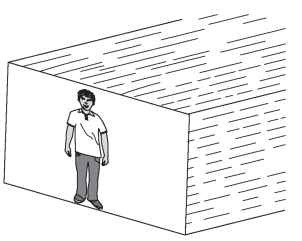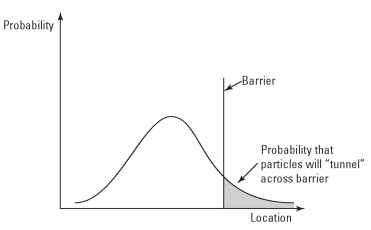With the four types of parallel universe described, it’s time to look at the fun part — whether there’s any way to reach them. Realistically, the answer is probably “No,” but that’s not the most interesting option, so the following sections look into ways that some of these universes might be able to interact with our own.
A history of hyperspace
To access a Level 1, 2, or 4 universe, you’d have to find a way to traverse an incredibly large distance in a moment’s time, a task made more difficult by Einstein’s speed limit — the speed of light. One of the only ways to achieve this would be by using extra space dimensions — sometimes called hyperspace — to cut down the distance.
Where are those extra dimensions, anyway?
Current string theory models postulate ten space dimensions (plus one time dimension). Our observed universe appears to have only three space dimensions (plus the one time dimension). String theory offers two possibilities for the extra dimensions:
The extra seven dimensions extend off of a 3-brane on which our universe resides.
The extra seven dimensions are compactified (likely into a Planck length radius shape), while our three space dimensions are uncompactified. (This is the dominant string theory viewpoint.)
You can picture a modified version of the first possibility by looking at Figure 15-1, which shows a universe of people living on a 2-brane. A third dimension extends off of that brane.
In theory, there could be some means for the 2-brane residents to leave the 2-brane and experience the greater 3-dimensional reality, as in the classic novel Flatland. By extension, there could be a way for people in our universe to leave our 3-brane to travel in the extra dimensions.

Figure 15-1:
It’s possible that there are dimensions beyond our own, which we can’t access.
For the second possibility, the dimensions are compactified to sizes that are so small no one has ever observed them. As discussed in topic 11, some recent theories have indicated that these sizes could be as large as a visible fraction of a millimeter, and tests along these lines should take place at the Large Hadron Collider. Some speculative ideas (not even well developed enough to be called theories) have been put forth that these compactified dimensions could contain their own universes.
String theory also allows for the possibility that some regions of the universe would have large extra dimensions, allowing them to interact with the current three dimensions in meaningful ways. No models suggest that this is actually happening in our universe, but the theory allows for such behavior.
Wormholes: Busting out of three-space
Even before string theory, the idea existed that the geometry of the universe would allow for shorter paths between points. In fiction, this can be seen in stories such as Lewis Carroll’s Alice in Wonderland, and in science, it can be seen in the wormholes, as depicted in Figure 1-4 in topic 1.
A wormhole is a shortcut to go from one location on a surface to another, just as a worm can dig through the center of an apple to get from one surface to another (thus the name). This concept arises from Einstein’s theory of general relativity, proposed years before string theory was conceived. These traditional wormholes connect different regions in the same universe and, as you can see in topic 16, have been exploited for many outlandish theoretical purposes, despite the fact that no one knows for sure whether they exist. (So what’s one more!)
Similarly, it’s possible that in a brane world scenario, we are somehow touching or connected to another brane. If these branes overlap, it’s conceivable that there would be a way to travel from the space of one brane to the space of another brane. (This is not the standard way that multiple branes interact in string theory. Much more common are the brane world scenarios from topic 11, where separate branes host difference pieces of the physics of our universe and then interact gravitationally.)
It’s unlikely that such a brane jump would take place merely by stepping into a mirror, but something as powerful as a wormhole might do the trick. It’s possible that a wormhole — generally hypothesized by general relativity as existing within rotating black holes and being notoriously unstable — might allow bits of matter or energy to slip from one universe into another parallel universe. If such strange events occurred at points where different branes overlapped in the bulk (the greater space that contains all of the branes), it’s unclear whether they might provide a way to get matter and energy from one brane to another as well.
In fact, one possible resolution to the black hole information paradox that has long been considered by some is the idea that information that enters a black hole exits into a parallel universe by means of a wormhole at the center of the black hole.
Such ideas are obviously highly speculative, but mathematical models have shown it’s feasible that some sort of wormhole — if held open by a form of negative energy — could provide a means of connecting different portions of space.
If this is the case, then the arguments in favor of parallel universes are on our side, because given an infinite universe and infinite time, everything is bound to happen somewhere. In a universe where parallel universes exist, travel between them may be guaranteed.
How quantum mechanics can get us from here to there
One other process of getting from one universe to another would be to use the property of quantum tunneling, which is where a particle is allowed to “jump” from one location to another across a barrier.
As topic 7 reveals, the uncertainty principle of quantum physics means that particles don’t have a definite location, but instead both the location and momentum of each particle are linked together with a sort of “fuzziness.” The more precisely you determine the location, the more fuzzy the momentum is, and vice versa.
This principle results in a strange phenomenon, known as quantum tunneling and shown in Figure 15-2. In this case, there is some sort of barrier (usually a potential energy barrier) that the particle shouldn’t be able to cross normally. But the graph, which represents the probability that the particle is in any given location, extends a bit across the barrier.

Figure 15-2:
According to quantum physics, sometimes particles can “tunnel” across barriers.
In other words, even when there’s an uncrossable barrier, there’s a slight chance — according to quantum mechanics — that a particle that should be on one side of the barrier may end up on the other side of the barrier. This behavior has been confirmed by experiment.
This provides a means that could in theory be used to access a parallel universe. Some cosmologists have suggested that exactly this physical mechanism is what started our own expansion as a universe.
The idea of quantum tunneling is key to the operation of electron-tunneling microscopes, which allow scientists to observe objects in incredibly fine detail.
Particles can only tunnel from a higher energy state into a lower energy state, though, so there are some limits on how this could be used, and the idea of using it to access another universe in a controlled way is way beyond current technology (or even current theory).
But for a sufficiently advanced civilization, one that has a theory that fully explains all aspects of physics and the ability to use vast amounts of energy, this sort of idea may be a possible means of getting to another universe.
Eaten by rogue universes
The assumption in this topic has mostly been that the separate universes described don’t normally interact with each other, but some approaches over the years have called this into question. One of the most recent is a 2008 paper in the journal Physics Review D by Eduardo Guendelman and Nobuyuki Sakai, in which they examine the idea of bubble universes to see if they could expand without the need for a big bang.
To make the equations work, Guendelman and Sakai had to introduce a repulsive phantom energy, which is possibly similar to dark energy. They found two types of stable solutions:
✓ The child universe, which is isolated from the parent universe (essentially a universe inside a black hole)
✓ A rogue universe, which is not isolated from the parent universe
This second kind of universe is troublesome, because as it begins to go through its inflation cycle, it does so by devouring the space-time of the parent universe. The parent universe is swept away as the rogue universe expands in its place — and it does so faster than the speed of light, so there’s no warning.
Fortunately, there’s no evidence that this phantom energy actually exists, or, if it does, it’s possible that it exists in the form of dark energy (or inflation energy), which means that we may be one of these rogue universes ourselves. As our universe expands, it may be devouring some other, larger universe!
